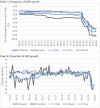Responses to COVID-19 in five Latin American countries
- PMID: 32874863
- PMCID: PMC7451099
- DOI: 10.1016/j.hlpt.2020.08.014
Responses to COVID-19 in five Latin American countries
Abstract
Background: COVID-19 reached Latin-American countries slightly later than European countries, around February/March, allowing some emergency preparedness response in countries characterized by low health system capacities and socioeconomic disparities.
Objective: This paper focuses on the first months of the pandemic in five Latin American countries: Brazil, Chile, Colombia, Ecuador and Peru. It analyses how the pre-pandemic context, and the government's responses to contain and mitigate the spread together with economic measures have affected the COVID-19 health outcomes.
Methods: Extensive qualitative document analysis was conducted focused on publicly-available epidemiological data and federal and state/regional policy documents since the beginning of the pandemic.
Results: The countries were quick to implement stringent COVID-19 measures and incrementally scaled up their health systems capacity, although tracing and tracking have been poor. All five countries have experienced a large number of cases and deaths due to COVID-19. The analysis on the excess deaths also shows that the impact in deaths is far higher than the official numbers reported to date for some countries.
Conclusion: Despite the introduction of stringent measures of containment and mitigation, and the scale up of health system capacities, pre-pandemic conditions that characterize these countries (high informal employment, and social inequalities) have undermined the effectiveness of the countries' responses to the pandemic. The economic support measures put in place were found to be too timid for some countries and introduced too late in most of them. Additionally, the lack of a comprehensive strategy for testing and tracking has also contributed to the failure to contain the spread of the virus.
Keywords: COVID-19; Chile; Colombia; Deaths; Ecuador; Effects: Brazil; Health; Latin America; Measures; Pandemic; Peru; Response.
© 2020 Fellowship of Postgraduate Medicine. Published by Elsevier Ltd. All rights reserved.
Figures





















References
-
- John Hopkins University of Medicine. Coronavirus resource center [Internet]. 2020. [cited 2020 Aug 10]. Available from:https://coronavirus.jhu.edu/map.html.
-
- Worldometers. Countries in the world by population (2020) [Internet]. 2020[cited 2020 Jun 10]. Available from:https://www.worldometers.info/world-population/population-by-country/.
-
- World Bank Group. World Bank open data [Internet]. 2020[cited 2020 Jun 10]. Available from:https://data.worldbank.org/.
-
- United Nations Development Program . United Nations; New York: 2019. 2019 human development index ranking.
-
- Brazilian Institute of Geography and Statistics. Population estimates sent to TCU [Internet]. 2019[cited 2020 Jun 10]. Available from:https://www.ibge.gov.br/en/statistics/social/population/18448-population....
LinkOut - more resources
Full Text Sources
